How to plant a lily?
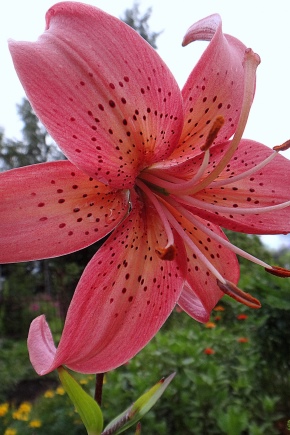
Lilies are very attractive and delicate flowers. They stand out for their large varietal variety. Different varieties, in turn, need individual characteristics of the content. In the process of planting, it is important to take into account all the nuances, and not to make mistakes so that the noble flowers take root well and delight the owners of the garden with their splendor for a long time.
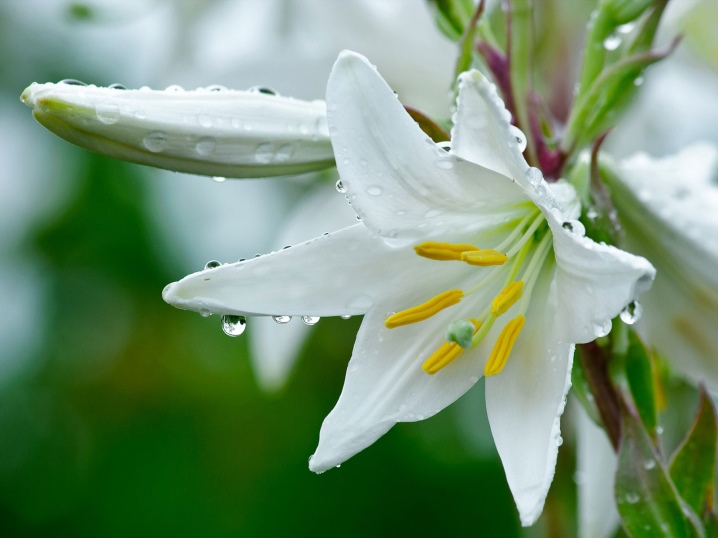
Timing
Gardeners usually choose the period for planting ornamental plants in open ground based on their personal capabilities and free time. Lilies can be planted in spring and autumn. But still, the most favorable time for bulbs, which are purchased from local growers, is in the autumn season. The optimal timing in the conditions of central Russia is late August - early October.
Planting at this time allows the root system to strengthen better and adapt to the upcoming growth of the plant. Planting at a later time will prevent the flowers from rooting well and the plant may die.
In the southern regions of the country, lilies can be planted from late September to mid-November.
If the temperature drops significantly or the first frost appears, the planted bulbs should be covered. Subsequently, after the end of winter, even a possible cold snap after a series of warm spring days will not frighten the lilies planted in autumn.
In specialized flower shops, planting material most often comes from Holland. It is worth considering the difference in climate and the fact that the bulbs are dug up for sale by suppliers in the fall, and then subjected to processing - drying and cooling. They arrive on the shelves of Russian stores only six months later - by the spring, and therefore they need to be planted in the next month after purchase.
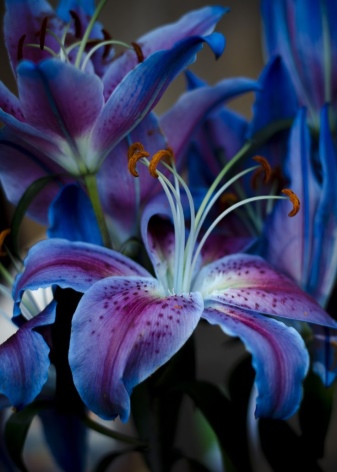
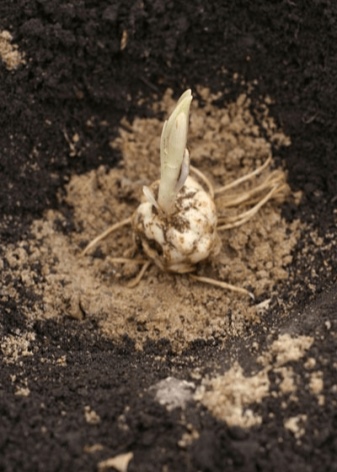
The best dates for spring planting are the end of April and May, when the soil has finally warmed up and there will be no frosts on the soil. In case of unstable weather, planting in summer in the first decade of June is permissible.
Site and soil requirements
The difficult point in breeding lilies is the observance of certain conditions of keeping for different species. They have different requirements for relief, lighting, protection from wind and ground.
Lighting
Lilies should not be planted in low or humid locations. It is more comfortable for them to grow on hills, where snow melts faster and moisture does not linger.
Most garden lilies prefer open areas where the sun can easily penetrate.
Only oriental varieties and martagon hybrids feel good in the shade. Asian varieties are unpretentious to lighting - they can delight with their flowering anywhere in the summer cottage area.
For planting lilies, you need to choose places that are protected from a strong through wind, since their petals and stems are not stable.

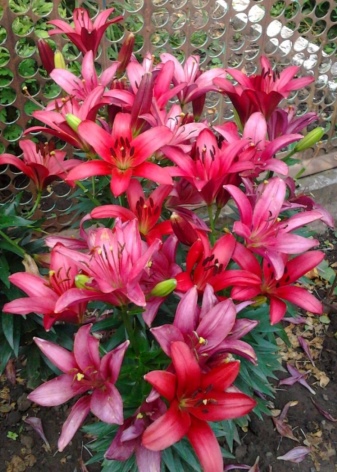
The soil
In one place, lilies can grow for about 5 years, so it is better to prepare the soil for planting thoroughly and in advance. Lilies cannot tolerate poor, heavy, clayey and stony soils.
For most hybrid varieties, the soil should be loose and mixed with sand, as it is an important component of their growth. If coniferous trees grow on the site or in its vicinity, then you can add their fallen needles to the mixture, as it increases the acidity of the soil. The addition of peat is encouraged.
For tubular and specific varieties of lilies, acidic soil, on the contrary, is undesirable. A neutral soil with the addition of ash is suitable for them.
Leopard and Candida varieties like slightly alkaline soil with a small admixture of lime.
Long-flowered, tiger and Canadian species prefer slightly acidic soils.
If the composition of the soil on the site is in doubt, then it is better to mix it with ash and a small amount of sand for planting lilies. Such a composition will be safe.
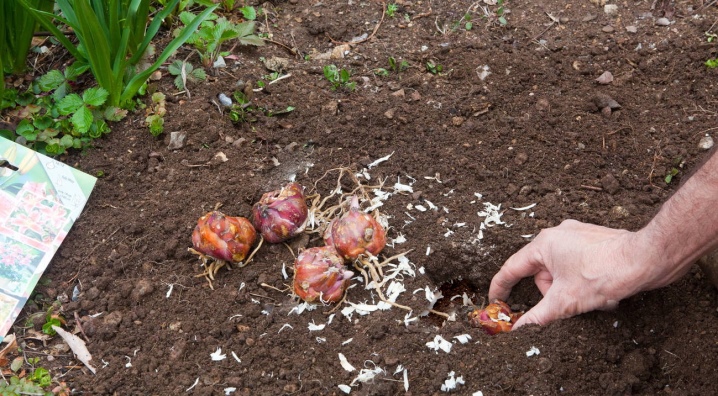
How to plant correctly?
Lilies of any variety look very beautiful on the site. In order for them to please with their flowering for more than one year, it is imperative to observe the planting technology.
If the planting material was purchased in the fall or prepared independently, but for some reason it was not planted, then until spring it must be stored in the refrigerator on the lower shelf.

Bulbs with sprouts
If sprouts form on the bulbs, they can no longer be stored without planting. They need to be planted in pots for indoor flowers or transparent containers, having previously made small holes in them for air to enter. Transparent containers are good because in them you can better observe the peculiarities of the development of the root system. For pot planting, purchased soil for lily species or universal is suitable.
You do not need to deeply bury the onion with the sprout. According to the rules, it must be planted so that the top of the sprout is level with the ground. If the sprout has hatched recently and is very small, then its tip should be left on the surface without covering it with soil.
Place pots or containers of planted lily bulbs in a cool but well-lit area. Window sills or shelves near windows are fine. In darkened rooms, if a small amount of light hits, you can additionally use a special ultraviolet lamp.
Watering is done infrequently, once a week is enough. The plant does not need fertilizing during this period. The bulbs are kept in pots until spring, and then planted in garden beds.


In open ground
Lily bulbs purchased in the spring can be stored in cool places, where the temperature is kept around 0 ° C, in plastic bags with small openings for air until planting.
The bulbs must be carefully checked before planting, to remove poorly adhering scales and wilted roots. In order to avoid the ingress of pathogenic bacteria, it is recommended to rinse them in clean water and immerse them in a weak solution of potassium permanganate for 20-30 minutes.
It should be planted in pre-prepared soil. It is necessary to dig up the area, add and mix the additives necessary for a particular type of lily, and arrange a flower bed with a height of about 20 cm.
There are practically no differences when planting ordinary bulbs and those grown with sprouts in open ground. If the sprout has grown by more than 15 cm, then it can be placed in the hole under a slight lateral slopeso that one side is closer to the ground, and the sprout itself does not stick out particularly strongly above its surface. This method will protect delicate shoots from frost. In two weeks, the sprouts will again assume an upright position, and they will no longer be afraid of spring temperature drops.
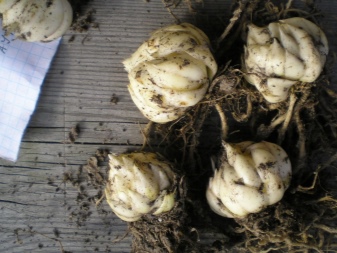
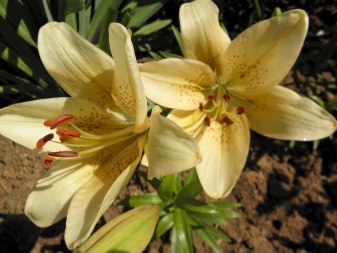
We list the main stages of planting.
- Preparation of planting holes. When digging them up, you need to focus on the description of the variety and the size of the bulb. The depth of the grooves should correspond in height to 3 bulbs placed on top of each other - about 8-12 cm.Leave the distance between them for low-growing varieties at 15-20 cm, for tall representatives - 20-30 cm.
- Planting bulbs. Place a small layer of small drainage stones or sand at the bottom of each hole. If possible, you can add sphagnum moss, as it has bactericidal properties and will protect the plant from decay and other diseases. Lower the onion on this layer and carefully spread the roots, then pour sand on top again. It is needed to absorb moisture.
- It is good to sprinkle the bulbs with soil, close the holes (with the exception of those in which specimens with grown sprouts are planted), you can add a little peat and water abundantly.
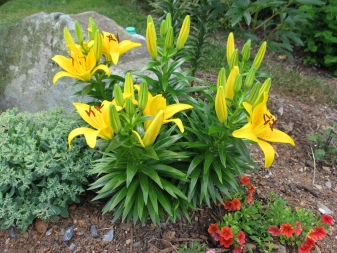
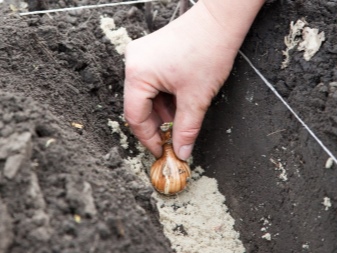
Follow-up care
Lilies are considered capricious plants, but still caring for them is not difficult. If the necessary conditions for their development and growth are observed, they retain their decorative properties for a long time, do not undergo diseases and age slowly.
When planting in autumn, they are watered only when the weather is dry and there is no rain. It is not worth worrying about the vulnerability of the plant to pests, since before the shoots appear, they are absolutely not interested in it. It is not necessary to fertilize lilies until spring.
Before the onset of cold weather, the garden bed can be covered with dry leaves or branches. The shelter will protect not only from frost, but also from the penetration of snails or slugs.
In the spring-summer period, you need to carefully look so that the soil of the plants is moderately moist. Lilies cannot stand excessive moisture, it is destructive for them.
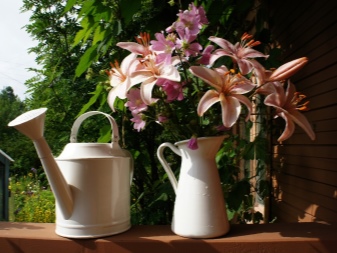
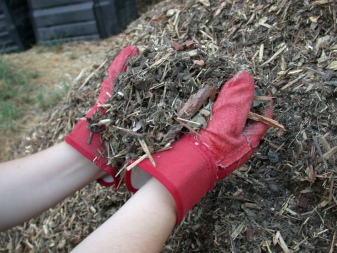
In the absence of rain, watering should be carried out once a week, pouring water at the root. The optimal time for watering lilies is the first half of the day before 15.00, by the night the soil should dry out.
Lilies of the first year of planting rarely bloom, as they need time to gain strength. If gardeners have a great desire to see flowering plants in the first summer, then the flowers need to be fed more often. You can stick to the following fertilization schedule:
- calcium nitrate - 2 times in the spring, apply the second dressing 20 days after the first;
- fertilizers with phosphorus - one month after the application of potassium, and then you can add about 1 time in 10 days until buds form;
- potassium magnesium is added when buds appear every 2 weeks and stop 1 week before flowering;
- potassium monophosphate - apply 2 times after the plant has bloomed.



Fertilization should be carried out in liquid form in accordance with the attached instructions.
Cut
Lilies look great in bouquets but you need to cut them off correctly:
- you can not cut the peduncle very low - this negatively affects the subsequent ripening of the bulbs, it is advisable to leave most of the stem in the flower bed;
- the cut site must be treated with ash and a small drop of medical glue should be applied so that it heals faster and does not rot in rainy weather
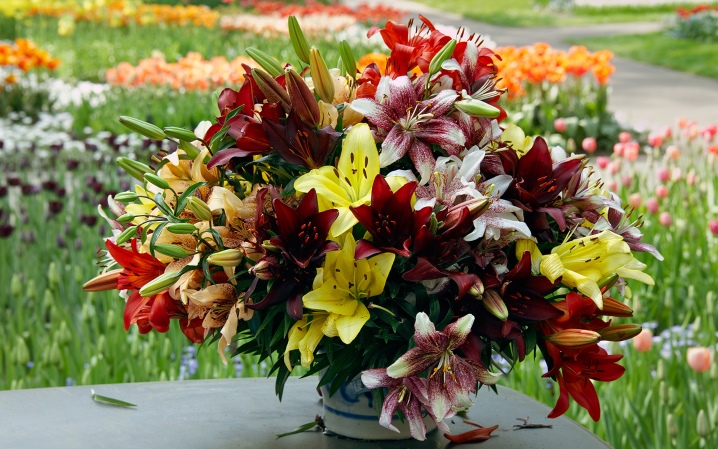
After flowering
Withered flowers must be removed so that seed boxes do not form.
In autumn, when a yellow pigment appears on all leaves, it is necessary to cut off the stems of lilies at a height of 12-15 cm from the ground. In the spring, these old stems will fall off on their own, or they can be pulled out without any effort.

Shelter for the winter
Not only bulbs planted in autumn, but also adult plants need insulation for the winter. After trimming the stems, you need to cover them.
The best material for warming will be fallen leaves of apple or pear trees, covering with spruce branches and peat is permissible. These layers can be covered with plastic wrap and secured with stones.
In spring, the film and spruce branches are removed, and peat or foliage can be left as fertilizer under the plant roots.
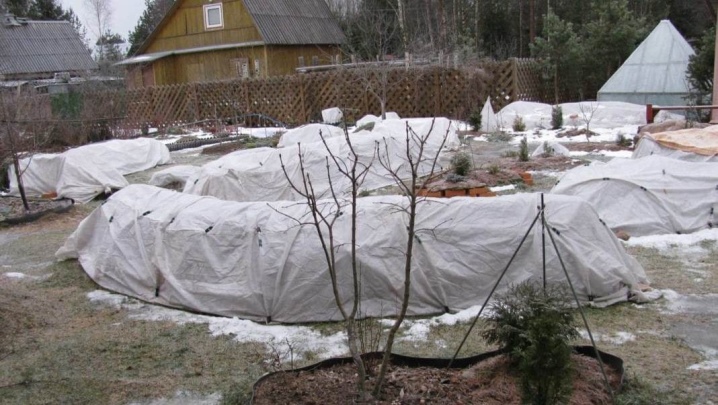
Transfer
Experienced growers know that plants need a transplant after a certain time. Those who have recently become interested in flower cultivation often have doubts about determining the time of the optimal transplant and its expediency in general. Sometimes it is very difficult to decide on this process if visually it seems that the plant is quite comfortable.
Lilies, like most plants, need this procedure. The meaning of transplanting is based on the fact that the plant takes nutrients from the soil. Each culture is content with its own specific set. And if the same type of plant grows in the same place for a long period, the soil fertility gradually deteriorates, the ecological balance of the soil changes.As a result, without a transplant, the stems and leaves of the lily may not stop growing, but the flowers will be smaller and paler over the years, the brightness will disappear.
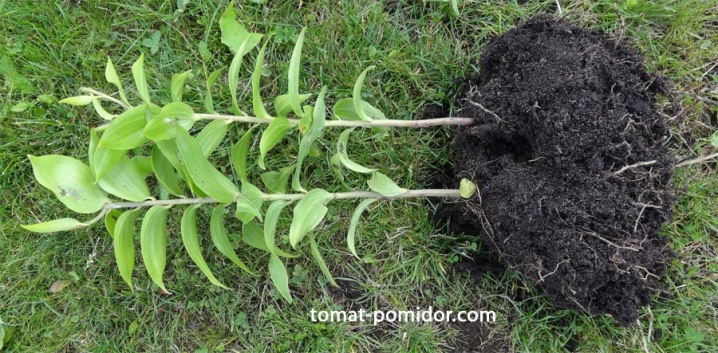
In one place without transplanting, different varieties of lilies can grow safely and give their flowers from 2 to 10 years. Some types of lilies (narrow-leaved, umbellate, monochromatic) tend to grow very quickly. If at the site of the dying peduncle more than two replacing processes appear annually, then the plant should be transplanted after 2-3 years.
It is advisable to replant Asian hybrids after 4 years. Candidium lilies in one place feel good for 5 years. The curly lily and Shovitsa variety root very poorly, so it is better to replant them after 6-7 years. Less often than all, after 9-10 years, Marchagon and American varieties of hybrids require transplantation.
Transplanting should be done when the plant is dormant, that is, about a month after it has faded. The only exceptions are varieties of oriental hybrids, since they bloom later, and it is better to transfer the transplant to the spring. The bulbs can be dug up on the eve of frost and stored in a cool place until spring comes.
Finding brown spots on the stem or leaves of a lily indicates that it is uncomfortable, the supply of nutrients has been exhausted, and it is better to transplant it, and not waste time on additional feeding. Usually, when digging up such a specimen, you will notice damage to the bulb by rot. If the rot is superficial and easily removed, then the bulb after treatment with a fungicide can be transplanted to another place on the site or left for storage until the spring transplant.
When transplanting, it is important to adhere to the same rules as for the initial planting of lilies:
- pre-prepared fertile soil in accordance with the requirements of the variety;
- well lit place;
- lack of gusty winds.

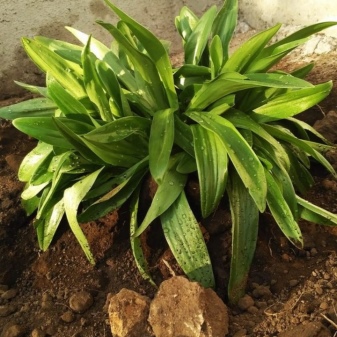
Correct planting technology, good flower care will preserve the bulbs and help their further growth in the spring. Growing lilies and caring for bushes is not so difficult, the main thing is to take into account all the nuances described above.
Compatibility with other plants
Lilies look great in any planting. They are often planted along paths, in group compositions, ridges and mixborders.
When decorating a large flower bed with different plants, you should correctly take into account the blooming period of flowers. Lilies need to be given a prominent place, but so that after the end of their flowering, empty stems are not conspicuous. It is preferable not to the foreground at the edge of the flower bed, but to the middle central part of the composition. It is important to correlate the height of the lilies with other companions. They will look graceful only if other plants obstruct no more than half of its peduncles when viewed from any angle of the flower bed.
In the foreground of the group composition, perennials will look spectacular, which tend to retain their decorative effect throughout the summer season. These include: astilbe, hosta, hyssop. You can break several group plantings of lilies by planting phloxes with small inflorescences, asters, peonies or echinacea between them.
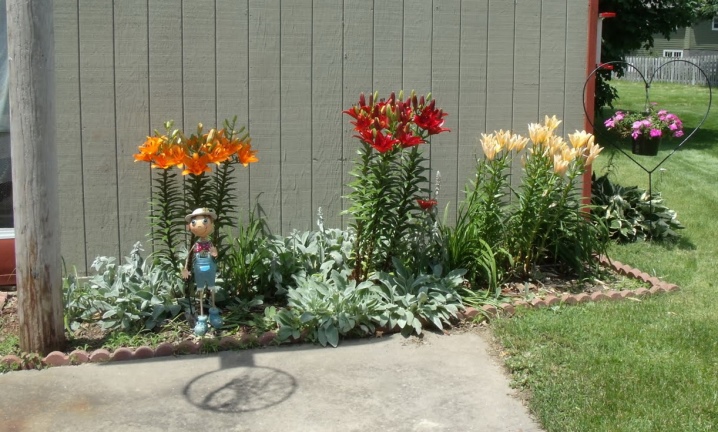
Bells, medium-sized varieties of marigolds, heuchera, alissum, garden cloves, and spurge can create a wonderful background for flowering lilies.
Lilies will look gracefully against the background:
- vertical gardening of the wall of a house, fence or gazebo;
- medium-sized shrubs of juniper, thuja;
- tall ornamental grasses - fern, lightning, pennisetum.
If you plan to create a multi-tiered flower bed only from lilies, then it is better to choose varieties belonging to their different groups. Plant low-growing varieties in the lower plan, as they bloom a little earlier. Plant the central place with medium-sized specimens, and the background, respectively, with the tallest. Varieties can be separated from each other by planting ornamental grasses.
Lilies are often used when decorating borders; their single-line plantings look more attractive in alternation with tall peonies or dwarf spireas.
Many gardeners are wondering whether it is appropriate to plant roses and lilies next to each other in the same flower bed. Subject to certain color combinations, such a neighborhood is quite acceptable.
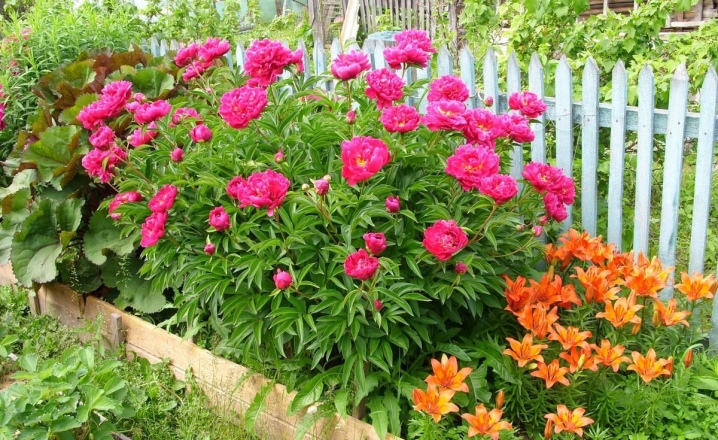
White roses can be placed in the foreground of the flower bed, and tall lilies with darker flowers can be planted behind them. Yellow or beige roses will harmonize with bright orange lilies. In the presence of a single pink or red rose bush on the flowerbed, you can plant light lilies in groups, they will emphasize not only the splendor of the rose, but also attract the eyes.
In general, lilies coexist well with most plants. It is undesirable to plant them only on one flowerbed with tulips, or to replace them. These flowers are susceptible to the same diseases and pests, so it is better to place them in different places in the garden.
There are a lot of options for decorating a garden with lilies, the main thing is to plant the varieties you like in accordance with their requirements, and observe the necessary care.
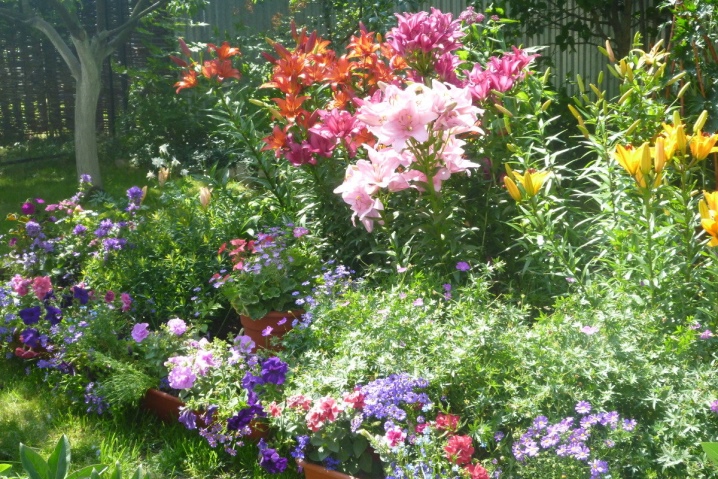
Also watch a video on how to plant and transplant a lily.







































































































The comment was sent successfully.